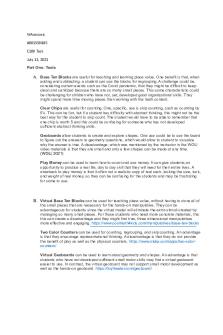C109 Task 1 - C109 Task 1 PDF

| Title | C109 Task 1 - C109 Task 1 |
|---|---|
| Author | kaitlin gaston |
| Course | Educational Technology for Teaching and Learning |
| Institution | Western Governors University |
| Pages | 5 |
| File Size | 95.2 KB |
| File Type | |
| Total Downloads | 104 |
| Total Views | 191 |
Summary
C109 Task 1
...
Description
Part A Use/Application of Manipulative 1: Dice can be used to help students understand the concept of probability. Advantage of Manipulative 1: Regular dice are easy to find. Disadvantage of Manipulative 1: Dice are hard and could be a potential safety hazard if a student threw one at someone else. Use/Application of Manipulative 2: Base ten blocks can be used to teach students about place value. Advantage of Manipulative 2: Base ten blocks can be used to teach multiple concepts besides place value, like addition, subtraction, counting, and number sense. Disadvantage of Manipulative 2: There are multiple sized pieces and many of them are small which can make base ten blocks difficult to keep up with. Use/Application of Manipulative 3: Legos can be used to help students learn how to measure the areas and perimeters of squares and rectangles. Advantage of Manipulative 3: Legos incorporate kinesthetic learning, giving math a real-world basis by giving students a real-world object to feel. Disadvantage of Manipulative 3: Legos have many small parts and could be a potential choking hazard. Use/Application of Manipulative 4: Cuisenaire rods are a great manipulative for students to use to practice addition and subtraction. Advantage of Manipulative 4: Cuisenaire rods are made from durable plastic and can withstand prolonged usage without needing to be replaced. Disadvantage of Manipulative 4: Buying Cuisenaire rods in bulk for a classroom is pricey. Part B Use/Application of Virtual Manipulative 1: Virtual geoboards can be used to teach students about area and perimeter. Advantage of Virtual Manipulative 1: Virtual geoboards are available for free on many websites. Disadvantage of Virtual Manipulative 1: If the teacher doesn’t have enough computers in the classroom, the whole class may need to travel to the computer lab for access to virtual manipulatives. Use/Application of Virtual Manipulative 2: Virtual currency can be used to teach students to count money using addition and subtraction. Advantage of Virtual Manipulative 2: Virtual currency saves the teacher money by not having to replace lost or damaged paper or plastic pieces. Disadvantage of Virtual Manipulative 2: Virtual currency’s disadvantage is the lack of hands-on involvement that helps students connect the pretend currency to the real world.
Use/Application of Virtual Manipulative 3: Virtual fraction circles can be used to help students compare fractions. Advantage of Virtual Manipulative 3: Virtual fraction circles are a visual representation of parts of a whole. Disadvantage of Virtual Manipulative 3: Virtual fraction circles are not designed to support cooperative learning. Use/Application of Virtual Manipulative 4: Virtual two-colored counters can be used to teach students how to add and subtract positive and negative integers. Advantage of Virtual Manipulative 4: Virtual two-colored counters can be used to model and teach many math topics. Disadvantage of Virtual Manipulative 4: Virtual two-colored counters may not meet the needs of students who are not familiar with computers or who learn better with hands-on manipulatives.
Part C: Lesson Plan Template GENERAL INFORMATION Lesson Title & Subject(s): Solving Addition Word Problems Using Base Ten Blocks Topic or Unit of Study: Addition Grade/Level: Kindergarten Instructional Setting: This lesson will take place in a Kindergarten classroom with 12 students, of which 2 are ELL students, and 1 has IEP for Autism. The classroom is arranged with centers around the perimeter (reading nook, pretend play/dress-up, computer area, art, etc.) and a large white board and a SMART Board on the main wall with a carpet area for seating. There are 4 tables with 3 chairs at each table in the center of the room for students to sit while working in small learning groups. STANDARDS AND OBJECTIVES Your State Core Curriculum/Student Achievement Standard(s):
CCSS.MATH.CONTENT.K.OA.A.2 Solve addition and subtraction word problems, and add and subtract within 10, e.g., by using objects or drawings to represent the problem. Lesson Objective(s): Given base ten blocks and a worksheet with ten addition word problems, students will correctly solve the word problems using the base ten blocks with 80% accuracy. MATERIALS AND RESOURCES Instructional Materials: SMART Board, projector, base ten blocks, pencils, addition word problems quiz Resources: http://www.corestandards.org/Math/Content/OA/ https://www.abcya.com/games/kindergarten_word_problems_add_to_10 INSTRUCTIONAL PLAN Student Prerequisite Skills/Connections to Previous Learning: Prior to this lesson, students will already be able to count to 20, understand that the last item counted represents the total number of items in a set, add and subtract numbers 1-10, and be able to read short sentences and identify key information. They will also have had experience with base ten blocks prior to this lesson. Presentation Procedures for New Information and/or Modeling: Teacher will use Smart Board and a projector to demonstrate how to solve addition word problems. Teacher will model using base ten blocks to solve the word problems. While demonstrating and modeling the teacher will also hold a whole-group discussion where she calls on students to answer questions or tell her what step to do next. For example, the teacher will project onto the board the following word problem: Sue has 3 apples. Mary has 3 apples. How many apples do they both have together? The teacher and students will work together via a think-aloud to solve the problem. Guided Practice: Students will sit at their tables and practice addition word problems using base ten blocks with their small groups. They will work together to complete a worksheet with 10 addition word
problems. For example: There are 5 red blocks and 2 green blocks. How many blocks are there altogether? During this time, the teacher will circulate around the groups and observe and listen as the students work through the word problems with their group. If any group or student is struggling, the teacher can ask guiding questions to facilitate discussion within the group. During this part of the lesson plan, each group will also create their own addition word problem and use the smart board and projector to show the other groups how they solved it. Independent Student Practice: Students will complete a quiz consisting of 10 addition word problems and use base ten blocks to solve them. Students will turn their quiz facedown when they finish, and the teacher will collect them as she walks around the room. Culminating or Closing Procedure/Activity/Event: After each student’s quiz has been collected, they will have a turn at one of the three classroom computers to play a game called “Molly Adds Up To 10.” In this game Molly is a unicorn who reads aloud various word problems that students must answer correctly so Molly can collect multi-colored magic beans to make a rainbow. Manipulatives are provided within the game virtually via objects on screen that can be moved around to practice adding to ten. Instructional Strategy (or Strategies): Cooperative learning groups, modeling, whole group discussion, think aloud, independent work, informal assessment (quiz) Differentiated Instruction Accommodations: The two ELL students will receive copies of the quiz that have been translated to their preferred language. For the student with the IEP I will provide direct instruction and read their quiz questions aloud to them. Use of Technology: SMART Board, projector, computers Student Assessment/Rubrics: Students will complete a quiz consisting of 10 addition word problems and use base ten blocks to solve them. Given base ten blocks and a worksheet with ten addition word problems, students will correctly solve the word problems using the base ten blocks with 80% accuracy. Part D: Justify Manipulative
During guided practice, students used base ten blocks to solve addition word problems while working in small groups. Base ten blocks enhance student learning because they provide a tactile and kinesthetic approach to make sense of math concepts. Additionally, base ten blocks enhance student learning because students can physically move objects around to better understand how numbers add together. Lastly, base ten blocks enhance student learning because they are a great way to encourage cooperative learning between students. Part E: Critical Thinking, Problem Solving, AND Performance Skills (Make sure to include a section on Critical Thinking, Problem Solving, AND Performance Skills) During guided practice, students used critical thinking skills when each group created their own addition word problem and solved it for the class, explaining their problem-solving process. I used cooperative learning groups to encourage critical thinking. This required critical thinking because the students collaborated with their group using the highest level of Bloom’s Taxonomy in order to construct their own original word problem. During guided practice, students used problem solving skills when working in groups to complete a 10-question worksheet with addition word problems using base ten blocks to find the solution. I used cooperative learning groups to encourage problem solving. This required problem solving because students are working together and using logic and the manipulative to find solutions to word problems. During presentation of new information and modeling, students used performance skills when listening and communicating. I used whole-group discussion to encourage performance skills. This required performance skills because students were listening and watching teacher model the concept while also being called on to answer questions or tell teacher what the next step should be, rather than teacher just solving the problem without student input. Part F: Instructional Strategy During presentation of new information and modeling, I used think-aloud when students did not have to raise their hands or wait to be called on to share their ideas. Think-aloud was effective because the teacher modelled their thought process with the manipulative and explained their thought process out loud so that students could better understand that process. This strategy also allows the teacher to assess students’ understanding of the concept. Thinkaloud is interactive and engaging for the students and teacher. By talking through the steps and reasons for those steps, students are able to internalize the material and build a better math foundation....
Similar Free PDFs

C109 Task 1 - C109 Task 1
- 5 Pages
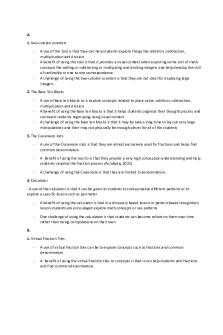
C109 Task 1 wgu.edu
- 8 Pages

C109 Math Methods Task 1
- 6 Pages
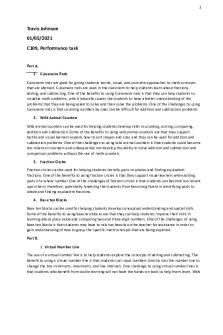
C109 performance task
- 10 Pages
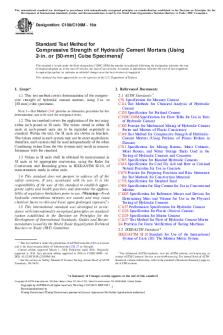
ASTM C109 - ASTM C109
- 10 Pages

PCE Task 1 - Task 1
- 2 Pages

Task 1 - SUS101 Task 1
- 2 Pages

Qht1 task 1 - Task 1
- 3 Pages

QBM1 Task 1 - Task 1
- 5 Pages
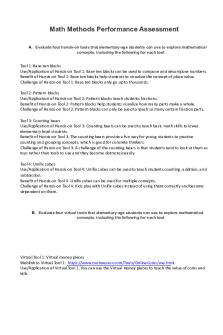
C109-2 - TASK2
- 10 Pages

C365 - Task 1 - Task 1
- 4 Pages

Task 1 - C226 Task 1
- 11 Pages

C304 Task 1 - TASK 1
- 16 Pages

DIT1 TASK 1 - Task 1
- 4 Pages
Popular Institutions
- Tinajero National High School - Annex
- Politeknik Caltex Riau
- Yokohama City University
- SGT University
- University of Al-Qadisiyah
- Divine Word College of Vigan
- Techniek College Rotterdam
- Universidade de Santiago
- Universiti Teknologi MARA Cawangan Johor Kampus Pasir Gudang
- Poltekkes Kemenkes Yogyakarta
- Baguio City National High School
- Colegio san marcos
- preparatoria uno
- Centro de Bachillerato Tecnológico Industrial y de Servicios No. 107
- Dalian Maritime University
- Quang Trung Secondary School
- Colegio Tecnológico en Informática
- Corporación Regional de Educación Superior
- Grupo CEDVA
- Dar Al Uloom University
- Centro de Estudios Preuniversitarios de la Universidad Nacional de Ingeniería
- 上智大学
- Aakash International School, Nuna Majara
- San Felipe Neri Catholic School
- Kang Chiao International School - New Taipei City
- Misamis Occidental National High School
- Institución Educativa Escuela Normal Juan Ladrilleros
- Kolehiyo ng Pantukan
- Batanes State College
- Instituto Continental
- Sekolah Menengah Kejuruan Kesehatan Kaltara (Tarakan)
- Colegio de La Inmaculada Concepcion - Cebu

